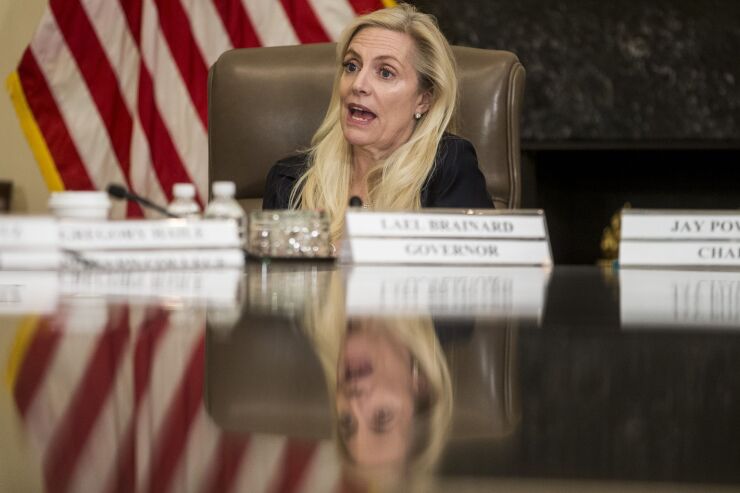WASHINGTON — The financial strain on households and businesses from the coronavirus pandemic “will likely create fragilities that last for some time,” heightening risk in the corporate debt market, the Federal Reserve said.
In its semiannual Financial Stability Report published Friday, the Fed said companies may face difficulties repaying debt given lower earnings, “which could trigger a sizable increase in firm defaults" and bank losses on certain business loans.
“Policy interventions may help businesses withstand a period of weak earnings by issuing new debt and extending existing credit, but many of these businesses will emerge with even higher amounts of leverage, suggesting that vulnerabilities stemming from the business sector, including nonpublic companies and small businesses, are likely to remain elevated for some time,” the Fed’s report said.
Although the economy before the pandemic was generally in a much better spot than in the lead-up to the 2008 financial crisis, volatility in the short-term money markets amplified the shock of the coronavirus to the financial system. The Fed was prompted early in the coronavirus crisis to take a number of actions, including slashing interest rates to zero and establishing several emergency lending facilities.

"Forceful early interventions have been effective in resolving liquidity stresses, but we will be monitoring closely for solvency stresses among highly leveraged business borrowers, which could increase the longer the COVID pandemic persists,” Fed Gov. Lael Brainard said in a statement.
The historically high levels of corporate debt that policymakers have been warning about for more than a year showed some troubling signs as defaults on leveraged loans ticked up in February and March at the onset of the pandemic, the Fed said. Those defaults are likely to increase, the report noted.
“Such developments would weaken the balance sheets of lenders, including [collateralized loan obligations] that hold leveraged loans, and amplify the economic effects of COVID-19,” the Fed said.
The origination of leveraged loans, however, slowed down considerably starting in February, and the issuance of those loans essentially came to a halt in March.
Consumer debt is also an area of concern for the financial system. The Fed reported that consumer credit card balances were almost $1 trillion at the end of 2019, and subprime or close-to-subprime borrowers accounted for about half of that amount.
Given the rapid spike in the unemployment rate — to 14.7% in April — the delinquency rates for those borrowers could overtake the highs of 2009 and 2010, according to the report.
The Fed also warned that although household debt was at a moderate level relative to income before the coronavirus, the inability of households to repay debt could result in material losses to lenders.
Still, banks thus far have been able to meet demand and perform relatively well given the magnitude of the coronavirus crisis, while at the same time building loan-loss reserves to absorb increased defaults. And many requests to draw on lines of credit were offset by a growth in bank deposits, which surged in February and March.
The Biden administration once again extended the pause on student loan payments enacted to help borrowers during the COVID-19 pandemic, this time through the end of August.
The two states' combined plans amount to over $1.5 billion of the Homeowner Assistance Fund included within the American Rescue Plan Act , which was passed a year ago.
An uptick in pandemic-related payment suspensions reflecting new or restarted plan activity previously occurred as the omicron variant spread, but activity has since subsided.
But the potential for a spike in credit losses as well as flat interest rates “have weakened the outlook for bank profitability, a key factor in banks’ ability to replenish capital,” the Fed said.
Although some of the Fed’s interventions have helped to walk back sharp declines in asset prices seen earlier in the year, asset prices could experience more significant declines if the coronavirus were to worsen or if the effects to the economy are further amplified.
While commercial and residential real estate prices have remained largely unchanged, those will also likely experience some stresses, the Fed said.
The Fed also warned about the possible strains on mortgage servicers given that borrowers with federally backed mortgages can request up to 12 months of forbearance.
Mortgage servicers are legally obligated to advance payments to investors, even if they do not receive mortgage payments from borrowers. This would particularly hurt nonbank mortgage services that don’t have the same liquidity resources as banks.
“In the short term, these strains could lead to curtailment of mortgage credit, and in the longer term, large-scale forbearance could cause some nonbank mortgage servicers to fail,” the Fed said.
Yet the central bank also highlighted the roots of this crisis outside the financial system, and said that the risks to financial stability will depend on how well the government can contain the spread of the virus.
If the coronavirus were to persist in the U.S. or if there were a second wave, it could put even more pressure on the financial system and could bring risks to the economy to the surface, according to the Fed’s report.
“A number of the vulnerabilities identified in this report could grow, making them more likely to further amplify negative shocks to the economy,” the Fed said.








